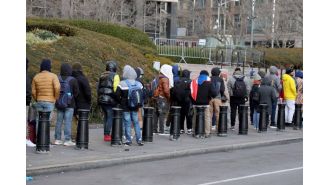What’s Next for U.S. Immigration Policy on the Southern Border?
We spoke to lawyers, health care providers, government officials and others to help workers understand their rights if they’re injured on the job.

Last week, President Joe Biden signed an executive order to curb immigration, effectively blocking most asylum claims when border crossings spike to a certain level. The move comes amid mounting concerns from across the political spectrum over immigration, which has emerged as a major voter issue this election year.
Some Democrats and human rights advocates have warned the Biden administration that the executive order could exacerbate the humanitarian crisis at the border, putting immigrants at greater risk as they wait on the Mexican side of the border. A recent analysis by ProPublica and The Texas Tribune found lawmakers, advocates and government officials previously issued similar warnings that went unheeded before a fire in a Ciudad Juárez, Mexico, detention center killed 40 men in March 2023.
Two weeks before the fire, which was one of the deadliest incidents involving immigrants in Mexico’s history, the Congressional Research Service published a report saying that the Mexican government did not have adequate resources to handle the influx of U.S.-bound migrants. “As a result, migrants remain vulnerable to crime and other abuses,” the report concluded.
The ProPublica and Tribune examination, which was accompanied by an 18-minute documentary titled “The Right Way,” unpacks the deadly consequences of policies such as Title 42, an emergency health code used by former President Donald Trump to slow immigration and continued under Biden. Even though the pandemic-era policy, which enabled the quick expulsion of 2.8 million immigrants, ended in May 2023, migrants continued to be stranded in Mexican cities because of other U.S. policies.
The week before Biden’s executive order, ProPublica and the Tribune hosted a virtual panel with experts to discuss U.S. policies that contributed to the fire, changes to the U.S. asylum system and why immigration has become a leading concern among voters as they prepare for this year’s presidential election. Speakers included:
Below are excerpts from the panel’s discussion, which have been edited for clarity and concision.
Perla Trevizo: We’ve been hearing a lot about a crisis — Biden’s crisis, the border crisis. Is there really a crisis, and what do we mean by that?Andrew Selee: The American public overwhelmingly thinks it’s a crisis. At least four polls that came out recently tell the same story, which is that Americans are quite pro-immigration, but they’re also really worried about the border. This cuts across party lines now. Yes, Republicans are more concerned about the border than Democrats, but Democrats have moved on this issue as have independents.
When you have a system that can’t make decisions about who should come into the country, that undermines the credibility of your immigration system. It makes people more worried about immigration in general and less willing to support things like legal pathways that would actually help.
We don’t have a crisis in terms of our well-being as a society, but we do have a crisis in terms of being able to make decisions about who comes in and keep some sort of control over immigration policy. I’m worried if we don’t figure this part out, we’re going to see a backlash against immigration that will hurt all of us.
Maureen Meyer: As the administration looks to reduce numbers at the border so that it doesn’t seem like a crisis, what you end up having is a humanitarian crisis on the Mexican side of the border. As numbers have dropped here, especially since last December, Mexico is encountering over 120,000 migrants a month. So what you have is a crisis that you’re exporting farther south.
Trevizo: We’ve recently seen a significant drop in border apprehensions or encounters, which is not common for this time of the year. We’re hearing a lot about numbers going up or down and Mexico’s role in it. What do these numbers tell us?Victor Manjarrez: Normally, I would say that that’s pretty significant, but that 50% drop is compared to December, when we had historically large numbers in terms of arrests along the southwest border.
Even with that drop, it’s estimated that there is going to be between 1.6 to 1.7 million arrests. The high-water mark was 1.6 million in 2000 for the longest time. When the numbers went up in 2022 and 2023 to 2.2 million, it was crushing because it does a number of things. You have to collapse your operations, and you have to vacate areas to handle the flows that come in.
The dynamic used to be that most people try to evade early detection. Now, people surrender to claim asylum. That doesn’t take away from the fact that it takes a large number of resources, from transportation to the logistics of processing.
Watch the Panel Discussion
Selee: I think you want three elements. You want people to be able to come on legal pathways to take available jobs. Right now, we have 8 to 10 million jobs a month that are open, and it’s a very tight labor market. You want a way of connecting employers with willing workers. We don’t have that right now. We have a system built in 1990 that has numbers set in stone by Congress 34 years ago in a different economy. That’s one element you have to update.
Secondly, you need a refugee system where people who are fleeing things that would put their lives in danger can get into the United States through asylum, either by applying at the border or ideally earlier. Ideally, we want a humanitarian protection system that starts in the region, particularly since we know most people are coming from somewhere in Latin America and the Caribbean, but then has a fail-safe at the border.
You have to be able to return people who don’t meet those two characteristics: who aren’t coming on a legal pathway and aren’t granted asylum. You have to make decisions on protection fairly quickly, by the way. If it takes four or five years, which is what it takes right now to get a decision, you’re not giving protection to people who need it. But you’re also creating a pull factor for people who might not have otherwise applied for protection. We don’t tend to remove a lot of people who’ve been in the country that long. People know that if they make it to the U.S. border, they are likely to get in.
That’s a system that doesn’t make sense for people who need protection, but it also doesn’t make sense from a migration protection standpoint. We then turn to Mexico and other countries along the way and say, let’s make it harder for people to get here. We would be much better off with a system that gave protection that had legal pathways but also returned people who don’t come through those ways. But we’ve ended up with a system that simply tries to slow people down.
Trevizo: When you talk to the administration or when you hear Homeland Security Secretary Alejandro Mayorkas talk, they do point to legal pathways: the CBP One App, humanitarian parole, more guest worker visas. The administration was moving in that direction, but we’re still seeing record numbers. What happened?Selee: They’ve really stretched the limits of what they can do with the executive branch to create legal pathways. They’ve tried to increase employer interest. They created quite a large pathway for Cubans, Haitians, Venezuelans and Nicaraguans, groups of people where there are displacement crises. It made sense to stretch what they call humanitarian parole powers to allow people to enter the country and have a work permit for two years. They’ve tried to speed up asylum and create incentives for people to go to ports of entry to apply for asylum rather than going between ports of entry. But without resources, without authorities, without Congress, it’s hard to create legal pathways. Unless Congress gets involved, appropriates money and provides some authorities, particularly on the legal pathway side, it becomes very hard to get done.
We saw an attempt by Republicans and Democrats, but that fell apart so we’re back to where we were
Trevizo: The Senate recently revived a failed immigration bill, but once again, Congress tanked the bill. If it had passed, what would it have done?Selee: It would have codified some of the things they did to restrict asylum. For decisions on asylum, it would’ve put more money into the Border Patrol and into ICE, for processing people and for returns. It’s a Band-Aid, but sometimes Band-Aids are important too. It would have at least created a more virtuous cycle for people who have strong asylum claims to present themselves at the border and a disincentive for people who know they don’t have strong claims.
On the flip side, Mexico came out for the first time ever with a national strategy on migration. How does Mexico relate to its own diaspora, i.e., the 12 million Mexicans that live in the U.S.? How does Mexico deal with asylum-seekers? Like with the U.S., it’s a question of resources and authorities and how you actually do it.
Trevizo: Immigration is a top issue for voters. On the one hand, Biden has tightened his position on immigration. On the other hand, you have Trump saying that he would call for mass deportations. Heading into November, what do you expect to see around immigration?Meyer: In terms of the Biden administration, we will continue to see a harder-line policy. President Biden and Mexico President Andrés Manuel López Obrador spoke a few weeks ago and talked about how they’re going to increase enforcement to reduce the number of migrants reaching the borders.
If it is a Biden second term, we will hopefully see a shift back to expanding legal pathways, improving the system, adding more resources and a continuation of these programs, especially the regional programs.
With Trump’s first term, we saw canceling refugee resettlement numbers or dramatically lowering them, canceling programs that Biden restarted like the Central America’s Minors Program, building more wall and, as you said, increased mass deportation. It’s a very contrasting view of the situation at the border that will have stark differences come January 2025.
ProPublica is a nonprofit newsroom that investigates abuses of power. Sign up to receive our biggest stories as soon as they’re published.
ProPublica is a nonprofit newsroom that investigates abuses of power. Sign up to receive our biggest stories as soon as they’re published.






